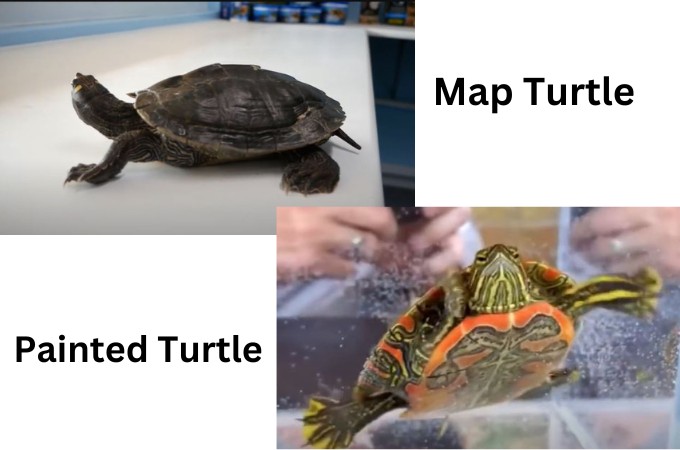Map Turtle vs. Painted Turtle: differences and similarities | turtlevoice
Today we discuss Map Turtle vs. Painted Turtle. Do you have a pet turtle at home? If so, it’s likely that your beloved shelled reptile is either a Map Turtle or Painted Turtle. But did you know that these two species of turtles are not actually the same? They may look and act similarly, but they have many distinct differences! In this blog post, we’ll explore both the Map Turtle and Painted Turtle—uncovering their unique features, behaviors, habitats, and diets so that you can get to know them more intimately. Read on to learn everything there is to know about these captivating creatures!
Map Turtle vs. Painted Turtle:
Map Turtle and Painted Turtle Species:
Map turtles and painted turtles are two fascinating species found in diverse freshwater habitats across North America. These enchanting reptiles captivate nature enthusiasts with their vivid markings, friendly demeanor, and intriguing behavior.
Map turtles get their name from the intricate, map-like patterns that adorn their shells, while painted turtles boast an eye-catching array of colorful stripes on their limbs, neck, and head. Although they share many similarities in their diet and nesting practices, these turtles differ in their size and preferred habitats.
Map turtles typically reside in large rivers and lakes with moderate currents, while painted turtles prefer calm, shallow waters with abundant aquatic vegetation. These charismatic creatures play a vital role in maintaining balanced ecosystems and provide endless fascination for wildlife enthusiasts of all ages.
So, the next time you’re out exploring nature, keep an eye out for these remarkable species and take a moment to appreciate their unique beauty and charm.
Comparison of Physical Characteristics:
The fascinating world of physical characteristics offers an abundance of intriguing comparisons as we observe differences and similarities between various species, as well as within our own human population. Delving into this realm of exploration, one can’t help but marvel at how diverse life on Earth truly is.
From the vibrant colors and patterns painting the wings of butterflies to the diverse skeletal structures allowing creatures to thrive in their unique environments, every detail is meticulously designed to serve its purpose.
Equally as enthralling is the study of human characteristics, which celebrates the complexities of our biological makeup while highlighting the unifying features that unite us all. Probing the depths of physical characteristics enriches our understanding of life and promotes an appreciation for the beauty that lies within the intricacies of nature itself.
Common Habitats for Each Species:
When exploring the mesmerizing world of wildlife, the fascinating differences in species’ habitats become increasingly clear. Each species has adapted to survive and thrive in a unique environment, and it’s crucial to understand these habitats in order to protect and preserve our planet’s biodiversity.
From the dense, sprawling tropical rainforests resplendent with life, to the serene beauty of underwater coral reefs teeming with diverse marine creatures, the natural world is truly a haven for an array of remarkable life forms.
As we take the unexpected journey to the soaring heights of rocky, windswept mountain ranges, we gaze upon agile mountain goats, demonstrating their exceptional climbing capabilities.
Similarly, within the vast, sweeping savannas or the arid desert landscape, we stumble upon creatures such as elephants, lions, or specialized reptiles that have evolved to withstand harsh conditions.
By understanding the unique qualities of the habitats that support these incredible species, we stand a better chance of ensuring their survival and continued existence on this extraordinary Earth.
Diet and Nutrition Habits:
A healthy lifestyle is incomplete without examining one’s diet and nutrition habits. In today’s fast-paced world, many people overlook the significance of incorporating a balanced diet into their routine. However, understanding the importance of diet and nutrition can work wonders for one’s physical and mental well-being.
By making mindful choices in our daily meals, we can fully experience the benefits that come with good health. We are empowered to take control of our bodies, and the energy levels needed to overcome life’s challenges.
Developing these essential habits not only contributes to a stronger immune system but also fosters a happier, more content way of life. In the end, it is vital to remember that the food we consume significantly influences our overall wellness – so making the effort to maintain a healthy diet and nutrition habits is an investment in our future.
Reproductive Behaviors:
Reproductive behaviors are fascinating aspects of the animal kingdom that have captured the interest of scientists and enthusiasts alike for generations. These diverse and intricate processes, driven by the evolutionary need to propagate their species, showcase the remarkable range and adaptability of life.
From mesmerizing courtship dances to complex systems of mate selection, reproductive behaviors vary significantly across the animal spectrum, reflecting their unique habitats, physical traits, and survival strategies.
As researchers continue to delve deeper into this mesmerizing subject, they are constantly uncovering new information, thus unveiling a wealth of insights into the underlying mechanisms that govern these fascinating behaviors.
In turn, understanding reproductive behaviors not only helps reveal the interconnected web of life as a whole but also holds the potential to enlighten us about our own reproductive instincts and practices.
Conservation Status of Both Species:
The conservation status of species is a critical indicator of the health of our planet’s ecosystems and biodiversity. By monitoring both endangered and thriving species, we gain vital insights into the challenges and threats that various habitats face.
A species’ conservation status acts as a ‘barometer’ for environmental changes and human impact, helping us identify necessary conservation efforts required to protect these precious natural resources.
By understanding the complex interactions within ecosystems, we can prioritize actions to ensure the long-term survival of species, supporting thriving habitats that benefit our planet and allow countless organisms to coexist harmoniously.
Ultimately, preserving the resilience of ecosystems is integral to our own well-being and that of future generations, as healthy ecosystems provide essential services such as clean air, water, and fertile soil for agriculture.
final word:
The map and painted turtles are two species that possess traits reflective of their individual ecosystems. From their physical characteristics to their nutritional requirements, it is clear that these species have adapted to successfully inhabit their environment even with growing threats from pollution and the steadily changing climate.
Hopefully, by understanding the differences between these two species, we can increase our conservation efforts to ensure both will survive for years to come. Without a commitment from all of us, future generations may not have the opportunity to admire these unique and diverse animals firsthand. With conservation practices grounded in education and awareness, however, we can remain dedicated to preserving these amazing creatures so they _will_ be around for future generations!

